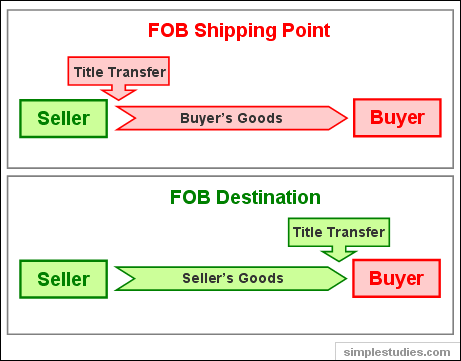What are FOB shipping terms?
1. Definitions of FOB shipping point and FOB destination
A computer manufacturing company sells its products and ships them across the country. It usually takes 5 days from the time a computer is shipped to the time it is delivered to the customer. During the transportation time, is the shipped computer still seller's inventory or already buyer's inventory?
The reason this question is important is because it determines when the manufacturing company, the seller, can recognize sales revenue and cost of goods sold. On the other side, the answer also dictates when the buyer can record the purchased inventory.
The answer can be obtained by looking at the shipping terms in a sales transaction. In practice, there are two general types of shipping terms:
FOB shipping point implies terms of sale under which title of goods passes to the buyer at the point of shipment. FOB shipping point is sometimes called FOB origin.
FOB destination implies terms of sale under which title of goods passes to the buyer at the point of destination.
N.B. FOB stands for free on board.
The illustration below provides a good depiction of FOB shipping point and FOB destination terms:
Illustration 1: FOB shipping point and FOB destination

From the illustration above, you can see that in the FOB shipping point scenario the title transfers to the buyer when the goods leave seller's premises: at that point the seller recognizes a sale, and the buyer recognizes a purchase. The customer usually pays for transportation and insurance when the shipping terms are FOB shipping point; the customer includes such expenditures in the cost of inventory purchased because they are considered product costs (transportation-in or freight-in costs).
In the FOB destination scenario, the title transfers to the buyer when the goods reach the buyer's premises; at that point the seller recognizes a sale, and the buyer recognizes a purchase. The seller usually pays for transportation and insurance when the shipping terms are FOB destination; the seller expenses such expenditures when they are incurred because they are considered period costs (transportation-out).
2. Example of FOB shipping point (FOB origin)
Let's assume that Manufacturer sells goods to Customer. The shipping terms are FOB shipping point. The transactions listed below took place between Manufacturer and Customer:
March 29: Manufacturer sold goods costing $15,000 to Customer at a price of $25,000. Customer incurred on account $2,000 for transportation and insurance of the goods. The time to deliver goods to Customer is 5 days:
Manufacturer |
Customer |
To record cost of goods sold: To record sales revenue: |
To record purchase of goods: To record transportation and insurance costs: |
April 2: Customer received goods purchased from Manufacturer:
Manufacturer |
Customer |
No entries to be recorded. |
No entries to be recorded. |
